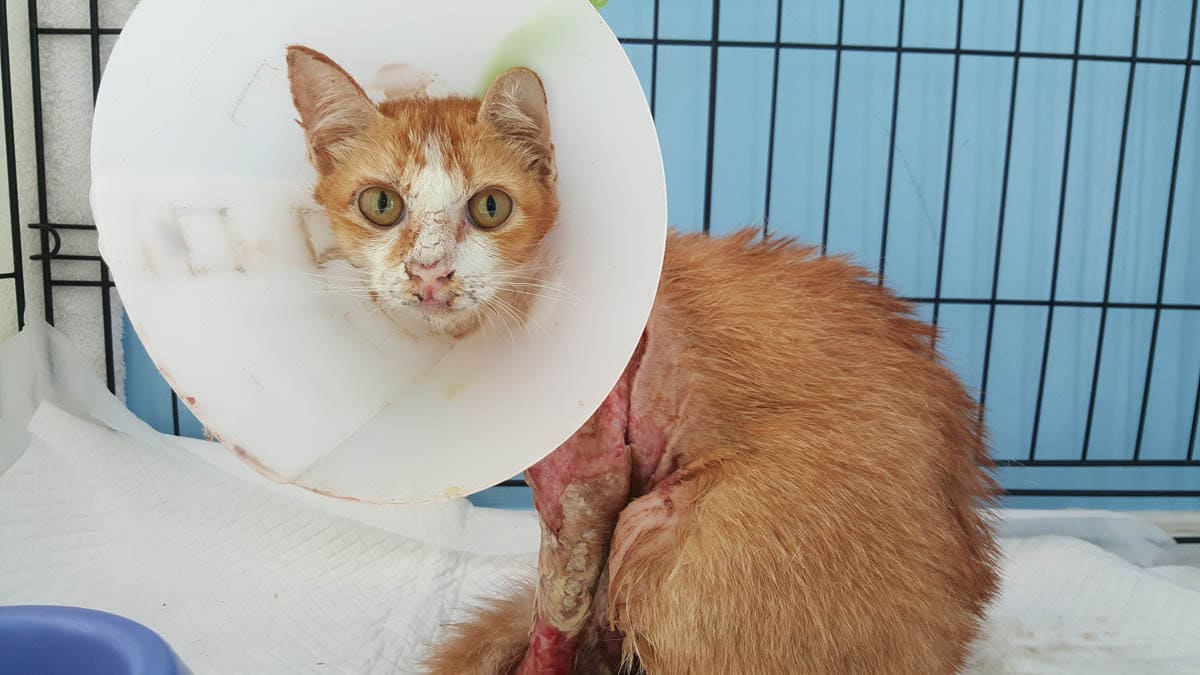Thankfully, burns to cats are uncommon, but they can and do happen. Kittens and young cats are more at risk than adults, due to their inquisitive nature. The majority of burns to cats occur as a result of cats jumping up onto a hot surface, such as a stovetop, other causes include sunburn (radiation burn), walking on a hot road (freshly tarred, or on a very hot day), or a metal roof, accidental burns can occur from open flames on candles, either lying too close, accidentally knocking one over or playing with the flames. White cats especially are vulnerable to sunburn, although it can affect cats of all colours. Places with less fur such as the ears and nose are most commonly affected. Kittens are known to chew, often indiscriminately and can receive an electric shock (and burn) from chewing cords.
This article refers mainly to thermal burns (from heat sources such as fire, scalding etc). Please read our other articles on electrical and chemical burns.
Symptoms

Obviously, this depends on the degree of the burns.
Burns are classified by how deep they penetrate the skin.
- First-degree burns (superficial) only affect the outer layer (epidermis) of the skin. The area is red, sore and may be swollen.
- Second-degree burns affect the epidermis and the dermis. Blisters form, the skin is very red and painful to the touch, severe swelling occurs.
- Third-degree burns (full-thickness) burns affect the epidermis, the dermis and the underlying tissues (such as muscle and bones. The area may be charred black or white, swelling, lack of pain (due to the nerves being destroyed).
If a large area is involved, the protective layer of the skin is absent, allowing fluids to be lost. This can lead to severe shock. Burns from liquid or steam will not cause a loss of hair. When the skin is broken, it becomes vulnerable to secondary bacterial infection, which is very common in burns.
Treatment
Again, this depends on the extent of the burns, how deep they are and how much of the body has been burned, obviously the greater the area, the more severe. All burns (even first degree) greater than 2% of the body should be seen by a veterinarian. Fur may or may not be present depending on the type of burn. Second and third-degree require immediate veterinary care, in the meantime, cover the burn with a cool, damp cloth while you transport your cat to the veterinarian. If possible, have somebody come with you to keep the cool cloth on your cat.
- First-degree burns can be flushed with cold tap water for 20 minutes, this helps to reduce damage, burns continue to “cook” the area even after the heat source has been removed. Apply aloe vera or antiseptic cream to the area and keep a very close eye on your cat while he heals. Never apply butter to a burn.
- Second-degree burns will need to be cleaned, and treated with an antiseptic and/or antibiotics. The area will be bandaged if possible.
- Third-degree burns are life-threatening and always require hospitalisation. Call the veterinarian ahead of time so that he can prepare for your arrival. Infection is a risk in cats with third-degree burns. IV fluids will be administered to correct fluid and electrolyte imbalances, antibiotics, and pain relief. The prognosis depends on the extent of the burns. Burns to more than 30% of the body has a poor outcome.
Home care
Watch for signs of infection and seek veterinary care immediately if you notice the area is oozing, inflamed or if your cat develops a fever.
Follow your veterinarian’s instructions.
Do not let a cat recovering from a burn outside until he or she has fully healed.

